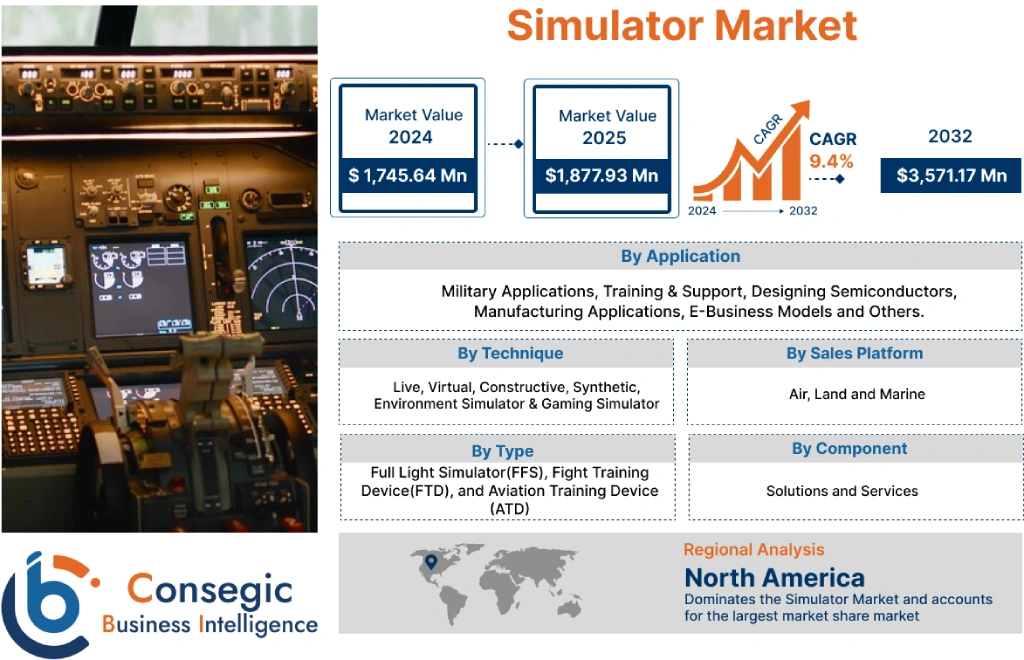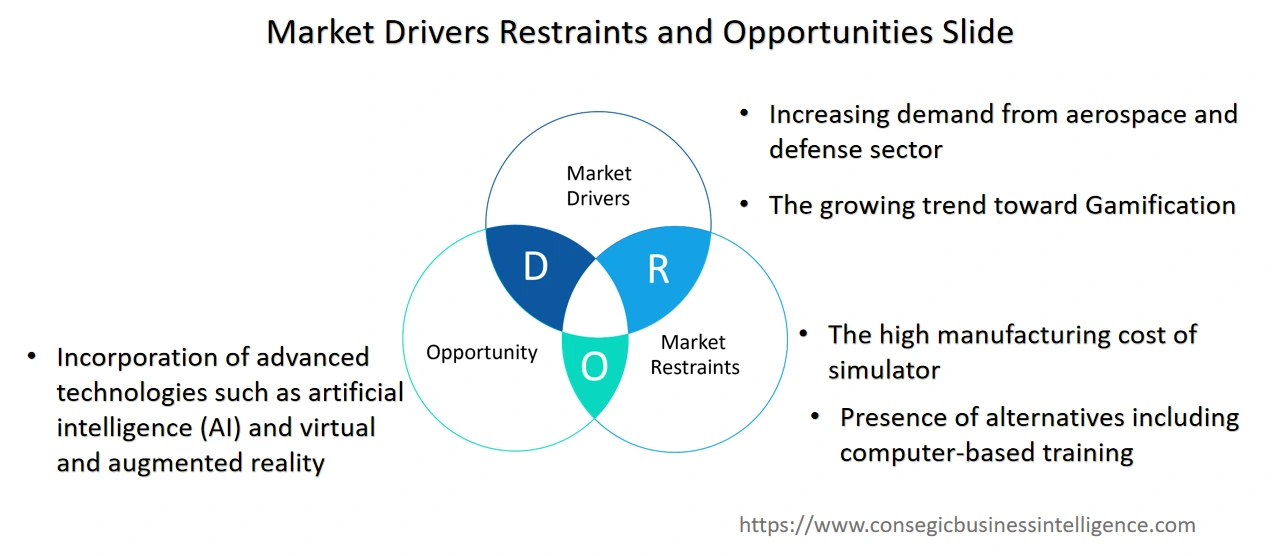Simulator Market Size :
Simulator Market size is estimated to reach over USD 3,571.17 Million by 2032 from a value of USD 1,745.64 Million in 2024, growing at a CAGR of 9.4% from 2025 to 2032.
Simulator Market Scope & Overview:
A simulator is a computer program or software application that models real-world processes or systems and allows users to simulate different scenarios and analyze the outcomes. these are widely used in many fields, including engineering, physics, chemistry, biology, medicine, economics, and social sciences. It's range from simple models to highly tors are also used to analyze and understand intricate systems or phenomena that are difficult to observe in the real world. For instance, simulators are used to evaluate the behavior of large-scale economic systems or the effects of different environmental factors on ecosystems. sophisticated software applications that use advanced algorithms and machine learning techniques. Additionally, simulators are also used to analyze and understand intricate systems or phenomena that are difficult to observe in the real world. For instance, simulators are used to evaluate the behavior of large-scale economic systems or the effects of different environmental factors on ecosystems.
How is AI Transforming the Simulator Market?
There is an emerging use of AI in the simulator market. AI integration helps in creating more efficient, personalized, and scalable training programs that reduce costs and increase effectiveness. It enables faster and more realistic scenario generation, provides real-time personalized feedback, and creates immersive, adaptive training environments for various sectors. Moreover, the integration of AI can automatically create diverse and complex scenarios from simple instructions, which enables massive testing and covers a wider range of use cases. Additionally, by automating tasks and reducing the need for human oversight, AI-driven simulators can lower operational costs, making training more accessible and scalable for organizations in aviation, military, and other sectors. Thus, the above factors are anticipated to boost the market growth in upcoming years.
Simulator Market Insights :
Key Drivers :
Increasing demand from aerospace and defense sector
The growing adoption of flight simulators in the aerospace and defense industry is one of the significant drivers for the growth of the market. Flight simulators are used to train pilots on various aircraft and to simulate a wide range of real-world scenarios, including emergency situations, system failures, and adverse weather conditions. Additionally it provide a safe and controlled environment for pilots to practice their skills and develop proficiency without risking injury or damage to equipment. Moreover, these are also used to evaluate pilots' performance and identify areas for further training or improvement. it's Use in aerospace and defense is driving the growth of the global simulator market research as these are critical for ensuring the safety and effectiveness of aircraft and systems. For instance, in March 2023, Ansett Aviation Training (AAT) launched a new full-flight simulator training center in Dubai. The new training center will provide airlines and pilots with access to state-of-the-art digital twin simulation technology for pilot training and testing. Full flight simulators accurately simulate a wide range of scenarios and conditions, including various types of aircraft, weather conditions, and emergency situations thereby, driving the growth of simulators market.
The growing trend toward Gamification
The growing demand for gamification is a significant driver for the market growth. Gamification is the use of game elements and mechanics in non-game contexts, such as training and education. The incorporation of game elements such as scoring, achievements, and rewards allows simulator industry to make training and education more engaging and motivating for learners and improve the effectiveness of the training and education. Additionally, simulators that integrate gamification elements aid learners in retaining information more effectively and applying it in real-world scenarios. For instance, in January 2023, the UN Environment Program (UNEP) launched a simulator game and avatar using the latest cutting-edge motion capture technology. The game, called "Earth School," is designed to educate and engage young people in environmental issues and take action to protect the planet thereby promoting the growth of the market.
Key Restraints :
The high manufacturing cost of simulator
The high manufacturing cost associated with the stimulator act as a major restraint for the growth of the market. The development and manufacturing requires large investments in technology, equipment, and specialized personnel. Additionally, the price of research and development, hardware and software components, and testing is also high that limits the adoption of simulators in smaller organizations.
Presence of alternatives including computer-based training
The high production cost compels the organizations to seek alternatives, such as computer-based training instead of investing in simulators which in turn impedes the growth of the market.
Future Opportunities :
Incorporation of advanced technologies such as artificial intelligence (AI) and virtual and augmented reality
The advancements in technology including virtual and augmented reality and artificial intelligence are expected to create future trends & opportunities for the market. Virtual and augmented reality technologies enhance the realism and immersive Ness by creating more realistic visual and auditory environments. Advanced technology is projected to provide a more immersive and engaging training experience for pilots. Additionally, artificial intelligence enhances the capabilities of simulation by enabling the simulator to adapt to changing scenarios and conditions. Artificial intelligence is expected to improve the accuracy and effectiveness and make the them more versatile and adaptable to different training requirements. The integration of advanced technologies such as artificial intelligence and virtual and augmented reality are thus projected to create potential opportunities for market growth.
Simulator Market Report Insights :
| Report Attributes | Report Details |
| Study Timeline | 2019-2032 |
| Market Size in 2032 (USD Million) | USD 3,571.17 Million |
| CAGR (2025-2032) | 9.4% |
| Base Year | 2022 |
| By Component | Solutions and Services |
| By Type | Full Flight Simulator (FFS), Flight Training Device (FTD), and Aviation Training Device (ATD) |
| By Technique | Live, Virtual, Constructive, Synthetic Environment Simulator, and Gaming Simulator |
| By Platform | Air, Land, and Marine |
| By Application | Military applications, Training & Support, Designing Semiconductors, Manufacturing Applications, E-business models, and Others |
| By Geography | Asia-Pacific, Europe, North America, South America, Middle East & Africa |
| Key Players | Altair Engineering Inc., Kawasaki Heavy Industries, Ltd., CAE Inc., BAE Systems plc, Kongsberg Digital, Raytheon Technologies Corporation, L3 Harris Technologies Inc, Boeing Company, Frasca International Inc., Tecknotrove Systems Pvt Ltd |
Simulator Market Segmental Analysis :
By Component :
The component segment is bifurcated into solutions and services. Solutions dominate the market and offer a more comprehensive and customized approach to simulation. Solutions for this market are tailored to meet the specific needs of different industries and applications and are customized to reflect the unique requirements of individual organizations. Additionally, solutions incorporate the latest technologies and growth trends, such as virtual reality , cloud computing, and artificial intelligence, to provide a more advanced and immersive simulation experience. Moreover, the ability of solutions to provide a more comprehensive, cost-effective, and innovative approach to simulation systems contributes collectively to drive the market growth.
For instance, in May 2021, Altair released simulation solutions namely comprehensive computational fluid dynamics, and expanded capabilities in electronic system design. The release of Altair's simulation solutions provides significant enhancements to its CFD capabilities, allowing users to simulate more complex fluid dynamics problems with greater accuracy and efficiency. Also the Services are expected to register the fastest CAGR in the market during the forecast period. Service providers offer the services on a subscription basis, allowing customers to access simulation systems resources according to the needs, eliminating the high upfront costs of purchasing the simulators. Additionally, simulator services improve efficiency and productivity by reducing downtime and minimizing the cost of maintenance and repairs. In conclusion, the combination of cost-effectiveness, efficiency, and accessibility is expected to drive the demand for simulator services during the forecast period.
For instance, in September 2022, Kawasaki Heavy Industries launched Japan's first CRM (Crew Resource Management) training services using a VR simulator to facilitate safer helicopter operations. The simulator uses virtual reality technology to create realistic scenarios enabling pilots to practice decision-making skills and enhance their experience, thereby driving simulators market growth.
By Type :
The type segment is classified into Full Flight Simulator (FFS), Flight Training Device (FTD), and Aviation Training Device (ATD). Full flight simulators market dominate the market as FFS offers the most realistic simulation of flight operations and provide a fully immersive environment that replicates the experience of flying a real aircraft. Additionally, FFS is designed to simulate all aspects of flight operations, including takeoff, cruising, and landing. Further, FFS also simulates different weather conditions and emergency scenarios, providing pilots with a comprehensive training experience. The ability of full-flight simulators to offer realistic simulation is the key factor driving the demand of the market.
For instance, in November 2021, CAE deployed the first Boeing 737 MAX full-flight simulator in Europe for pilot training and certification. The FFS features the latest simulation technology, including high-fidelity graphics, realistic motion systems, and advanced avionics systems promoting the demand of the simulators market. Flight Training Devices (FTD) are expected to register the fastest CAGR in the simulators market as FTDs are less expensive than FFS and provide a cost-effective training solution for pilots. FTDs offer a realistic simulation of the cockpit environment and provide pilots with an immersive commercial training experience. Additionally, FTDs offer a wide range of simulation capabilities, including different aircraft types, weather conditions, and emergency scenarios, and are configured to simulate different types of aircraft, hence, suitable as a versatile training simulators tool.
Moreover, the market industry research report includes FTDs reduce training costs and time by providing a safe and controlled environment for pilots to practice their skills and also simulate a wide range of scenarios without the need for actual aircraft. The aforementioned factors including increased simulation capability and improved training efficiency contribute significantly to drive the growth of devices in upcoming years. For instance, in March 2023, AEGEAN and CAE partnered together to create Greece's first Advanced Flight Training Centre. The new training center will feature the latest devices to allow pilots to receive realistic training in a safe and controlled environment, hence, driving the demand of the simulators market.
By Technique :
The technique segment is categorized into live, virtual, constructive simulation, synthetic environment simulation, and gaming simulation. Live simulators dominate the market as the simulators offer the most realistic training experience by using actual aircraft simulation technology and physical environments, closely mimicking real-world scenarios. In addition, live simulators allow pilots to experience actual cockpit procedures, emergencies, and weather conditions, to prepare pilots for real-life scenarios and enhance their ability to respond to emergencies.
Moreover, live simulators have been used for decades and have established a reputation for being the most effective way to train pilots. Airlines and training institutes prefer to u\se live environment simulators due to their proven effectiveness, which in turn drives the growth of the market . Virtual simulators are expected to witness the fastest CAGR in the simulators market research report during the forecast period. The advancements in computer graphics and 3D modeling enable virtual simulators to provide a highly realistic training experience that closely resembles actual flight scenarios. Additionally, virtual simulators offer a high degree of flexibility to replicate different scenarios and environments, thus becoming ideal for training pilots on a variety of aircraft models, weather conditions, and emergencies.
In conclusion, the combination of flexibility and technological advancements makes virtual simulators an attractive option for pilot training programs and is expected to accelerate market growth in upcoming years. For instance, in March 2022, Mitsubishi Electric announced to launch "MELSOFT Gemini" 3D simulator to provide a highly realistic training experience to the pilots that closely resembles actual flight scenarios, contributing significantly to bolstering the growth of the simulator market.
By Platform :
The platform segment is trifurcated into air, land, and marine. Air platform dominates the market owing to the increasing demand for the simulators for pilot training to provide a safe and controlled environment for pilots to learn and practice their skills. In a simulated environment, pilots experience a range of scenarios and emergencies without the risk of injury or damage to equipment.
Additionally, air simulators are cost-effective as the stimulators reduce the need for actual flight hours in expensive aircraft and provide pilots with a realistic training experience at a lower cost than actual flight time. Consequently, the use of air platforms to provide a realistic experience and safety to pilots is driving the growth of the market. Land simulators are anticipated to witness the fastest CAGR owing to the growing applications in the automotive industry. Simulators provide a safe and controlled environment for driver training, allowing learners to practice the skills in a range of scenarios without the risk of injury or damage to equipment. Additionally, In this market research report are also used to test and refine vehicle designs including testing the aerodynamics, suspension, and handling of vehicles in a simulated environment. In conclusion, simulators serve as a valuable tool for the automotive sectors by allowing manufacturers to improve products, reduce costs, and enhance safety.
For instance, in March 2023, Deakin University's Advanced Design and Engineering Centre launched Australia's most advanced automotive driving simulator known as the Deakin Driving Simulator (DDS) to simulate a range of driving scenarios in a controlled environment. The DDS uses a 360-degree, high-resolution projection system and a six-degree-of-freedom motion platform to create a highly immersive driving experience, thereby promoting the growth of the simulator industry.
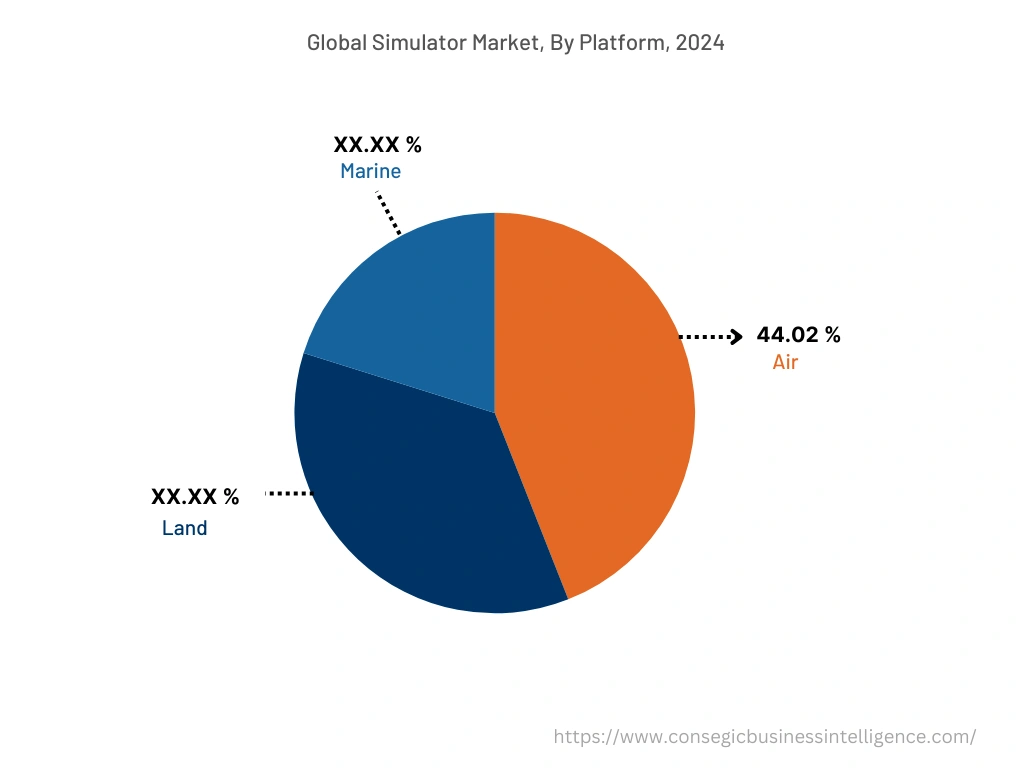
By Application :
The application segment is divided into military applications, training & support, designing semiconductors, manufacturing applications, e-business models, and others. Military applications dominate the market as flight simulators are used to train military pilots in a range of scenarios, including combat, aerial refueling, and emergencies. In addition, simulators are also used to train military personnel in the operation of ground vehicles, including tanks, trucks, and armored vehicles. Simulators facilitate simulating a range of terrain and weather conditions, allowing personnel to practice the skills in a variety of scenarios. Moreover, the ability to provide enhanced flight training and ground vehicle training experience is bolstering the growth of the simulator market.
For instance, in October 2022, VirTra introduced a breakthrough realistic 3D military simulator training, V-300 that provides an immersive and realistic training environment for military personnel. The simulator uses advanced technology to create realistic scenarios, including live-action videos and 3D graphics, to simulate a range of combat situations. simulators for training and support are expected to witness the fastest CAGR in the simulator market analysis during the period. Medical simulators are used to train healthcare professionals in a range of scenarios, including surgical procedures and emergency medical situations. Simulators provide a safe and controlled environment for professionals to practice their skills without the risk of harm to patients.
Additionally, simulators are used to train personnel in manufacturing processes and equipment operations to simulate a range of scenarios, allowing personnel to practice their skills in a safe environment. The increasing adoption in the healthcare and manufacturing industry is, therefore, projected to increase the application in training and support during the forecast period.
By Region :
The regional segment includes North America, Europe, Asia Pacific, Middle East and Africa, and Latin America.
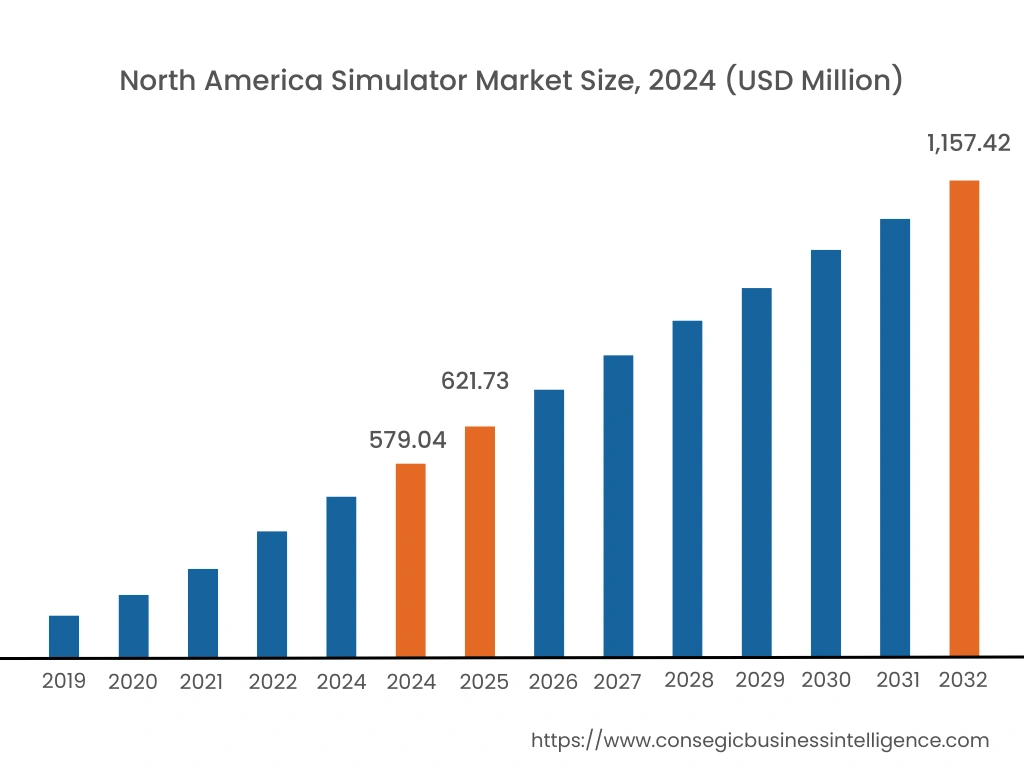
North America dominates market and accounts for the largest simulator market in 2024 valued at USD 579.04 Million registering a CAGR of 9.00% during the forecast period. In North America, the United States accounts for the largest market revenue share of approximately 44.7% in the given forecasts and the market growth is attributed to the high demand for simulators across various industries, including aviation industry, military, healthcare, and automotive.
Additionally, the early adoption of advanced technologies, including advanced simulation and modeling software, high-performance computing, and advanced graphics processing units is also fueling the growth of the market. Advanced technology allows for the creation of highly realistic and immersive simulators and propels market trends. Furthermore, governments in the region are also investing in the development and procurement to enhance training and safety measures in various industries.
For instance, in December 2021, the Government of Canada partnered with VirTra Inc. to supply simulators to various law enforcement, border protection, and corrections facilities. The adoption of advanced technology and investment by the government serves as the primary factors in driving the growth of the market in North America. Asia Pacific is expected to witness the fastest CAGR in the market due to the growing automotive industry. Simulators are used for automotive design and prototyping for the development of new models in the automotive industry. Market for simulators allow designers and engineers to test various designs and configurations virtually, saving time and reducing costs associated with physical prototypes.
Moreover, the presence of major companies in the region namely Mitsubishi Electric Corporation, CAE Inc., and Fidelity Technologies Corporation constantly apply innovations to strengthen the market position in Asia Pacific. The growing automotive industry and the presence of companies, therefore, serve as the key factors in promoting the companies market growth.
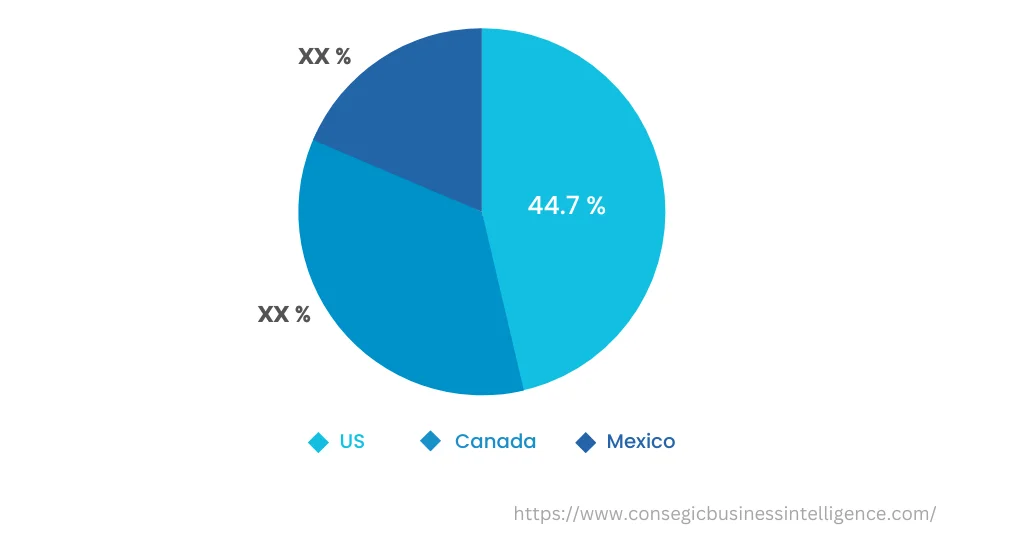
Top Key Players & Market Share Insights:
The simulator market is highly competitive, with several companies vying for market share. Companies often compete with one another by offering different types of simulators that cater to diverse applications and industries. In addition, the companies also compete based on factors such as price, quality, and customer service. Some of the key players in the simulator market include -
- Altair Engineering Inc
- Kawasaki Heavy Industries, Ltd.
- CAE Inc.
- BAE Systems plc
- Kongsberg Digital AS
- Raytheon Technologies Corporation
- L3 Harris Technologies, Inc.
- The Boeing Company
- Frasca International, Inc.
- Tecknotrove Systems Pvt Ltd
Recent Industry Developments :
- In March 2022, BAE Systems acquired Bohemia Interactive Simulations (BISim) to enhance BAE Systems' ability to provide cutting-edge simulation solutions to its customers in the defense industry.
- In February 2022, Kongsberg Digital (KDI)'s received a tender to supply a wide range of maritime simulators for South Metropolitan TAFE in Fremantle, Western Australia. The tender win highlights KDI's expertise and capability in providing advanced simulation technology for the maritime industry.
Key Questions Answered in the Report
What is a simulator? +
A simulator is a software application that imitates the behaviour or characteristics of a real-world system or process. Simulators are designed to create a realistic and interactive environment that is used to train, educate, or test various scenarios in a safe and controlled manner.
What are some of the most important applications of simulators, and how do they impact the industrys growth potential? +
Simulators have gained vast applications in aviation, military, and medical fields to provide realistic and safe training environments. For instance, flight simulators have the ability to simulate different flight conditions, emergencies, and instrument failures, allowing pilots to practice and improve the skills without risking their lives.
Which region/country is anticipated to witness the highest CAGR during the forecast period, 2025-2032? +
Asia Pacific is expected to witness the fastest CAGR in the simulator market due to the expanding automotive industry. Simulators are used for automotive design and prototyping and also to test various designs and configurations virtually, saving time and reducing costs associated with physical prototypes.
What specific segmentation details are covered in the simulator market report, and how does dominating segment impact the market growth? +
The report consists of segments including Component, Type, Technique, Platform, and Application. Each segment has a key dominating sub-segment being driven by industry trends and market dynamics. For instance, the application segment has witnessed military applications as the dominating segment in the year 2022, owing to the increasing use of flight simulators to train military pilots in a range of scenarios, including combat, aerial refueling, and emergencies.
